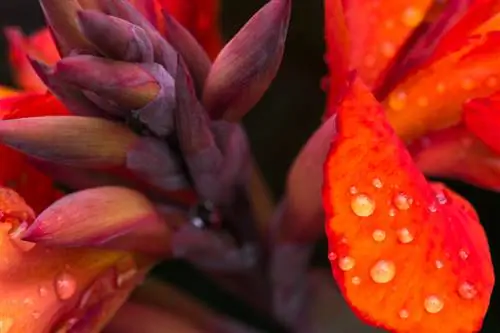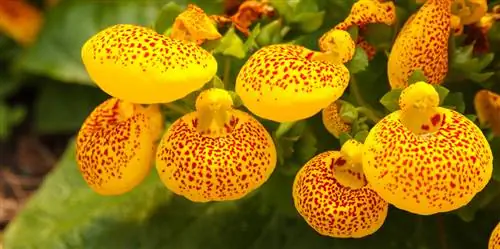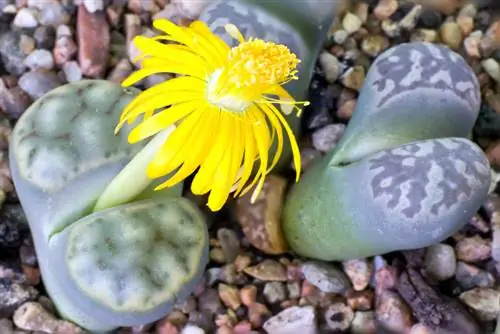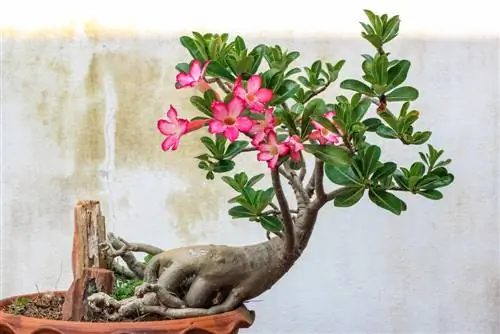- Author admin [email protected].
- Public 2023-12-25 17:45.
- Last modified 2025-01-23 11:22.
With palm-like leaves on its mighty trunk, the fern palm acts as an ambassador of tropical opulence. In order to cultivate the relic of prehistoric flora without errors, essential questions require a practical answer. Here you will find the tools you need to authentically care for cycads.
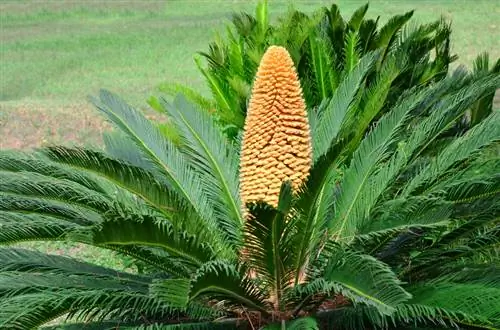
How do I properly care for a cycad?
When caring for a cycad, you should ensure there is enough space in the pot, bright to sunny locations, lime-free irrigation water and regular fertilization. In winter, place at 10-15 degrees Celsius and water less.
Planting cycads correctly
In the Central European climate, the tropical prehistoric plant thrives optimally in large containers. This should provide enough space for the expansive taproot and have an opening in the bottom for water drainage. This is how you plant the fern palm in an exemplary manner:
- Create drainage at the bottom of the pot with broken pottery shards (do not use calcareous gravel)
- Mix pot plant soil with lava granules and fill in the lower third of the pot
- Plant the young fern palm in the middle, repeatedly pressing the substrate.
Finally, water with lime-free water to place the plant in a partially shaded location for the first 2-3 weeks.
Care tips
Caring for a fern palm can easily be done even by hobby gardeners with limited time available. These measures are important:
- Damp the soil to the ground when watering
- Let the substrate dry before the next watering session
- Use collected rainwater or decalcified tap water
- Fertilize liquidly every 4 weeks from April to October
If the fern palm spent the summer outdoors, it moves to winter quarters when temperatures fall below 12 degrees. In a bright location at temperatures of 10-15 degrees, reduce the amount of irrigation water and stop adding fertilizer.read more
Which location is suitable?
In order for the fern palm to develop a harmonious silhouette, these location conditions are important:
- Bright to sunny lighting conditions
- No blazing midday sun
- Normal room temperatures
- Average humidity of 50-60 percent
A cycad feels particularly comfortable outdoors. It is best to take the plant to the balcony or garden in spring when temperatures consistently exceed 15 degrees. The even incidence of light during the summer promotes a harmonious habitus.
What soil does the plant need?
The fern palm spends many years in the substrate. Because of this, it is important to use high-quality compost-based potting soil. Add lava granules or expanded clay to optimize permeability. A few handfuls of ericaceous soil ensure the desired pH value of 5.5 to 6.0.
When is flowering time?
It is considered an accolade among hobby gardeners if you coax a flower from a cycad. From May onwards, either a male cone flower or a female sporophyll, the typical flower on ferns, emerges. It usually takes 6 to 14 months for the seeds to ripen.
Cutting cycads correctly
Since every new wreath of leaves on a fern palm is greeted with joy, cutting is rarely an option. If new leaflets rise in the crown, the lower leaf crown dies off. Give the cycad time to assimilate the remaining nutrients. Either the dead leaves fall off on their own or you cut them off with a disinfected knife.
Watering cycads
An even substrate moisture with intermediate drying phases is beneficial for growth. Water thoroughly with low-lime water and then wait until the soil surface has dried again.
Fertilize cycads properly
Nutrient requirements are at a low level. Fertilize a fern palm every 4 weeks from April to October with a liquid fertilizer for green plants.
Diseases
A look at the strong, leathery leaves suggests that diseases rarely occur on a fern palm. If the cycad stays outdoors in summer, powdery mildew or downy mildew can sometimes spread on the fronds. The mealy-gray patina will disappear again after you repeatedly treat the foliage with a mixture of 100 ml fresh milk and 900 ml water.
Pests
If the fern palm hibernates at temperatures above 18 degrees, mealybugs and mealybugs sometimes spread on the leaflets. Wipe off the pests with a soft cloth soaked in alcohol (€8.00 on Amazon). Alternatively, pack the root area in a plastic bag and rinse off the parasites.
Wintering
If the outside temperature drops below 10 degrees Celsius, the fern palm moves into the house or winter garden. This is how you overwinter the plant in an exemplary manner:
- Set up in a light-flooded location
- A temperature level of 10-15 degrees is ideal
- Water less often and do not fertilize
Year-round cultivation at room temperatures is possible. Given the reduced amount of light, the fern palm stops growing, reducing the need for irrigation water. The higher the temperatures, the sunnier the location should be.read more
Propagate cycads
Reproducing cycads by sowing is considered the ultimate challenge. In order for the seeds to germinate, temperatures of 30-35 degrees and a permanent humidity of 80 percent are required. It takes up to 3 months for the first cotyledons to appear.
Is cycad poisonous?
The fern palm is poisonous in all parts. Children should not come into contact with the plant unsupervised. Additionally, place cycad out of the reach of pets. The poison content can be removed from the seeds by roasting, making them suitable for consumption.
Cycad fern not blooming
Don't worry if cycads don't bloom even after years. In the local regions, a flower is considered a spectacular sensation. The more time the palm-like plant can spend outdoors, the better the chances of a female or male flower cone.
Brown leaves
If the powerful pinnate leaves turn brown from the tip, check the fern palm for these causes:
- Air that is too dry: spray repeatedly with lime-free water
- Drought stress: water thoroughly until the water runs out of the soil opening
If the tips of the leaves constantly encounter an obstacle, they will then turn brown. In this case, changing location solves the problem.
Yellow leaves
The exclusive use of calcium-containing irrigation water causes yellow leaves on a fern palm. If you switch the water supply to collected rainwater or decalcified tap water, the plant will recover over time.read more
How do I transplant correctly?
The peaceful growth of a fern palm requires transplanting every 3-4 years. If the roots protrude from the opening in the ground or push through the substrate, repot the cycad in February or March. Shake off the spent soil as much as possible. Dead roots are cut out with a sharp, disinfected knife. In the first 2-3 weeks after transplanting, the plant must not be exposed to direct sunlight.
The most beautiful varieties
- Japanese sago palm fern (Cycas revoluta): by far the most popular variety with 70-140 cm long fronds on the mighty trunk
- Zamia: this fern palm grows faster, has wider pinnate leaves and is easier to care for
- Rolled sago palm fern (Cycas circinalis): impresses with numerous leaves up to 150 cm long and long feathers
- Zamia furfuracea: on a very short trunk the curved leaves develop in dense bushes


